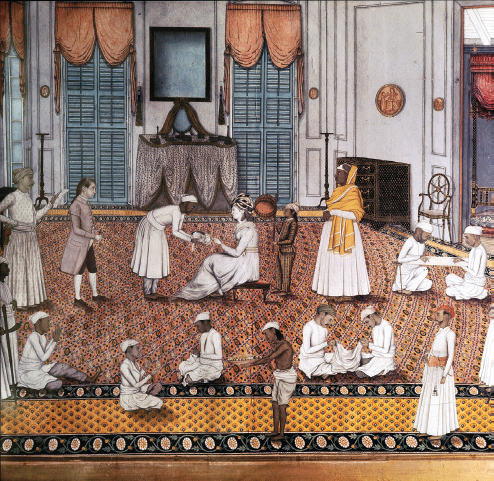Understanding Western Society
Printed Page 541
Trade and Empire in Asia and the Pacific
As the Atlantic economy took shape, Europeans continued to vie for dominance in the Asian trade. Between 1500 and 1600, the Portuguese had become major players in the Indian Ocean trading world, eliminating Venice as Europe’s chief supplier of spices and other Asian luxury goods. The Portuguese dominated but did not fundamentally alter the age-
Formed in 1602, the Dutch East India Company had taken control of the Portuguese spice trade in the Indian Ocean, with the port of Batavia (Jakarta) in Java as its center of operations. Unlike the Portuguese, the Dutch transformed the Indian Ocean trading world. Whereas East Indian states and peoples maintained independence under the Portuguese, who treated them as autonomous business partners, the Dutch established outright control and reduced them to dependents.


After these successes, the Dutch hold in Asia faltered in the eighteenth century due to the company’s failure to diversify to meet changing consumption patterns. Spices continued to compose much of its shipping, despite their declining importance in the European diet. Fierce competition from its main rival, the English East India Company (established in 1600), also severely undercut Dutch trade.
Britain initially struggled for a foothold in Asia. With the Dutch monopolizing the Indian Ocean, the British turned to India. Throughout the seventeenth century, the English East India Company relied on trade concessions from the powerful Mughal emperor, who granted only piecemeal access to the subcontinent. Finally, in 1716, the Mughals conceded empire-
Britain’s great rival for influence in India was France. During the War of the Austrian Succession, British and French forces in India supported opposing rulers in local power struggles. In 1757, East India Company forces under Robert Clive conquered the rich northeastern province of Bengal at the Battle of Plassey. French-
The rising economic and political power of Europeans in this period drew on the connections they established between the Asian and Atlantic trade worlds. An outstanding example is the trade in cowrie shells. These seashells, originating in the Maldive Islands in the Indian Ocean, were used as a form of currency in West Africa. European traders obtained them in Asia, and then traded them for slaves in West Africa. Indian textiles were also prized in Africa and played a similar role in exchange. Thus the trade of the Atlantic was inseparable from Asian commerce, and Europeans were increasingly found dominating commerce in both worlds.
>QUICK REVIEW
What role did trade and empire play in shaping European colonial policies in the seventeenth and eighteenth centuries?